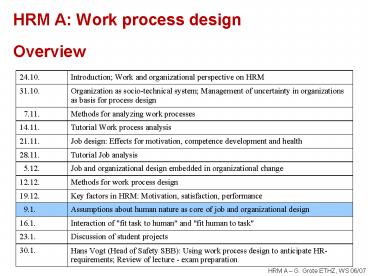HRM A: Work process design Overview - PowerPoint PPT Presentation
1 / 24
Title:
HRM A: Work process design Overview
Description:
HRM A G. Grote ETHZ, WS 06/07. Assumptions underlying work ... and. the more explicit the agreement. the sounder the psychological contract. ... – PowerPoint PPT presentation
Number of Views:82
Avg rating:3.0/5.0
Title: HRM A: Work process design Overview
1
HRM A Work process designOverview
2
Assumptions underlying work and organizational
design (from Ulich, 1998)
3
Assumptions underlying work and organizational
design (from Ulich, 1998)
4
The five principles of Taylorism
- Separation of planning and doing
- Responsibility for planning at management level
implementation as sole shopfloor responsibility - "one best way" of task execution
- Definition of the more efficient way of task
execution based on scientific methods every
worker executes only one step in the overall task - Selection of the best person
- Definition of qualification profile for each task
step, selection of the appropriate person - Reduction of training
- Training for the more efficient way of executing
each task step, workers are easily replaced - Control
- Surveillance of adherence to the prescribed work
methods and of achievement of required results
5
Assumptions underlying work and organizational
design (from Ulich, 1998)
6
Discovery of social man Human Relations movement
- Hawthorne Studies
- Study on the relationship between lighting and
performance based on tayloristic rationalization
-gt performance increases throughout the study,
even when lighting is reduced again to "moon
light quality" - Study on the relationship between breaks and
performance based on tayloristic
rationalization-gt Performance increases
independent of design of breaks - Hawthorne effect Social factors are crucial
for behavior, e.g. social attention through being
studied - (3) Systematic support for group cohesion
influences performance through formation of group
norms
7
Assumptions underlying work and organizational
design (from Ulich, 1998)
8
Criteria for humane work tasks (from Ulich, 1998)
9
Objectives of job design
- AutonomySelf-determination regarding goals and
rules for goal achievement. - ControlInfluence on situations in order to
achieve goals which can be self-determined or
determined by others. - Prerequisite for effective use of control
Transparency and predictability of work situation.
10
Assumptions underlying work and organizational
design (from Ulich, 1998)
11
Considering individual differences in job design
- Participative und differential-dynamic job
design - Involvement in organizational change decisions
and offer of choices regarding job design options
allows for consideration of indiviual needs and
competencies - Job crafting
- Opportunities for self-determined adaption of
work tasks according to changing individual needs
and competencies - Management by Objectives (MbO)Systematic
furthering of individual motivation through
tailored goals and ways for goal achievement - General objective no fixation of individual
differences, but individually tailored support
12
Assumptions about human nature (Schein, 1988)
13
Case Work organization in an insurance company
14
Goal setting theory
- Motivation through self-determined achievement of
goals. - Goals have to be...
- ... clear and specific,
- ... very difficult without being unrealistic
- ... accepted and longer-term.
- There hase to be continuous feedback on goal
achievement.
15
Practical implementation of goal setting theory
Management by objectives (Drucker, 1954)
- Systematic alignment of individual and
organizational goals - Breaking down strategic goals to each level of
the organization - Spezific, measurable, achievable, realistic goals
for each employee - Participative decision making
- Clearly definied time frame for goal achievement
- performance evaluation and feedback
- But MbO is just another tool, it is not the
great cure for management inefficiency. It works
if you know the objectives, 90 of the time you
dont.
16
Legal and psychological contracts
17
Flexible working Change from a tradtional to a
new contract? (Raeder Grote, 2001)
18
Fit between expectations and offers Employee
perspective
19
(Non-)Fit of employer offers and employee
expectations (Wittekind, Raeder Grote, 2005)
20
(Non-)Fit of employee offers and employer
expectations (Wittekind, Raeder Grote, 2005)
21
Career orientations in Switzerland (Swiss
HR-Barometer 2006, Grote Staffelbach)
Traditional career Independent career
Disengaged career
22
Career orientations in Switzerland (Swiss
HR-Barometer 2006, Grote Staffelbach)
- Traditional career - 39
- more men, lower education level, longer tenure
- more participation, more personnel development
- more employer offers (especially job security,
loyalty, career opportunities) - higher commitment, higher life satisfaction,
higher work-life balance - Independent career - 36
- younger, higher education level, higher income,
shorter tenure, more in insurance and banking,
higher employability - more work flexibility, less personnel
development - more expectations regarding interesting work,
learning opportunities, and taking on
responsibility - lower commitment, lower job satisfaction, higher
intention to quit - Disengaged career - 13
- more women, older, lower education level, lower
income - less participation, less personnel development
- lower expectations
- lower motivation, lower job satisfaction, lower
life satisfaction
23
Swiss HR-Barometer 2006Factors influencing
intention to quit
24
Psychological contract as leadership instrument
- Psychological contracts ...
- complement and super-impose legal contracts.
- contain reciprocal, though not necessarily
correspon-ding expectations and offers between
employee and employer. - are derived from verbal agreements as well as
from behaviors of contract partners and other
members of the organization.
- The more corresponding
- and
- the more explicit the agreement
- the sounder the psychological contract.































